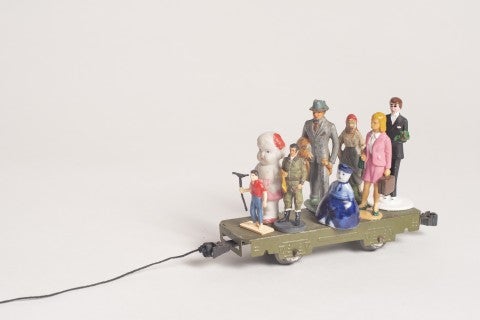For more than six decades, Liliana Porter (born 1941 in Buenos Aires) has created a clever and whimsical body of work that includes printmaking, works on canvas, time-based media, installations, and public art projects. Porter studied art in Mexico and Argentina before moving to New York in 1964, where she began her career as a printmaker. That same year, she co-founded the New York Graphic Workshop (NYGW) with artists Luis Camnitzer (b. 1937), then her husband, and José Guillermo Castillo (1938–1999). Together, they produced prints while redefining conventional models for making and distributing art. The workshop radically reexamined the print medium, shifting its focus from the traditional craft of printing individual images to championing a broader and experimental perspective. It produced unconventional manifestations of the medium, such as inking the sides of stacks of paper and using them to print on paper-based installations.
By the late 1960s, photography would replace printmaking as Porter’s primary medium. She explains, “In the 1960s, when I was doing that minimal work . . . I concentrated on the concept of reality and illusion. But later I focused more on content. I began to create narratives. And as I saw my preoccupations emerge—time and memory, for instance—these became more my subject.”
Porter created tiny worlds in her photographs, which she continued to explore in her video works. In both media, she arranged tableaus using figurines and toy objects against empty monochromatic backgrounds to create poignant, bizarre, humorous, and profound narratives. Her figurines were sourced from flea markets, antique stores, and other unusual places. “The objects have a double existence. On the one hand they are mere appearance, insubstantial ornaments, but, at the same time, they possess a gaze that evokes a certain pathos and a gaze that can be animated by the viewer, who, through it, can project the inclination to endow things with an interiority and identity.”
This effect is enhanced by the empty backgrounds, which forgo context and create contemplative environments. For Porter, “It doesn’t give you any clue about time or place. It makes it possible for the scene to be in the future or the past or the present.” Additionally, the direction—the exact placement of the camera, the angle of view, the narrowness or expansiveness of the frame, the use of closeup or distance—adds to the ironically emotional expression of inanimate objects. The human condition or existence is projected onto the toys, which seem to embody our own perceptions, histories, and memories of the world.
Cuentos Inconclusos/Unfinished Tales (2022), co-directed by Porter and the artist Ana Tiscornia, features a moving score by composer and sound designer Sylvia Meyer. Over nearly eleven minutes, Porter’s tiny found figures and objects inhabit a white space, portraying tales that are disparate and unresolved. Like a silent movie, vignettes are introduced by fragmented subtitles that suggest they are mid-story or even mid-sentence. Cut from old books or magazines, the lines hint at a narrative—“A happy encounter” and “Though it seemed strange”—and pose metaphysical questions—“Who are you?” and “Where are you going?” Rather than unfolding complex dramatic acts, these modest figures present simple situations in which their blank faces and immobile bodies lead us to reflect on the human condition. True to its title, the video features open-ended scenes that encourage viewers to generate meanings and create their own conclusions.
Porter creates surprising juxtapositions of objects as well as scenes with isolated figures, such as a heart-wrenching view of “A peculiar animal”—a blue dog with large, saucer-like eyes. Shot from overhead, this solitary figure looks up at the viewer, with the potential to bring tears to one’s eyes.
Some vignettes loosely dramatize the text. The line “Since he had filled his bag with diamonds” is followed by a view of silver discs falling onto a figure holding a large basket. Others ponder existential questions like “What will become of me?” posed for a duck examining a cut-out image of a woman made from red paper.
Porter also tenderly portrays the dissolution of a couple’s relationship, from the miniature bride and groom locked in an embrace under blue light, gradually transitioning to plain-clothed figurines that become more distanced until the female figure exits the frame.
This succession of short takes culminates on a similarly poignant note. The phrase “And they did not stop walking day and night until finally…” introduces a stop-motion scene of figurines traversing a pencil-drawn labyrinth. Eventually, all but two figures disappear, and Unfinished Tales concludes with a face-to-face encounter between a man and a woman, suggesting this ending is a new beginning—leaving the tale unfinished. —Kanitra Fletcher

